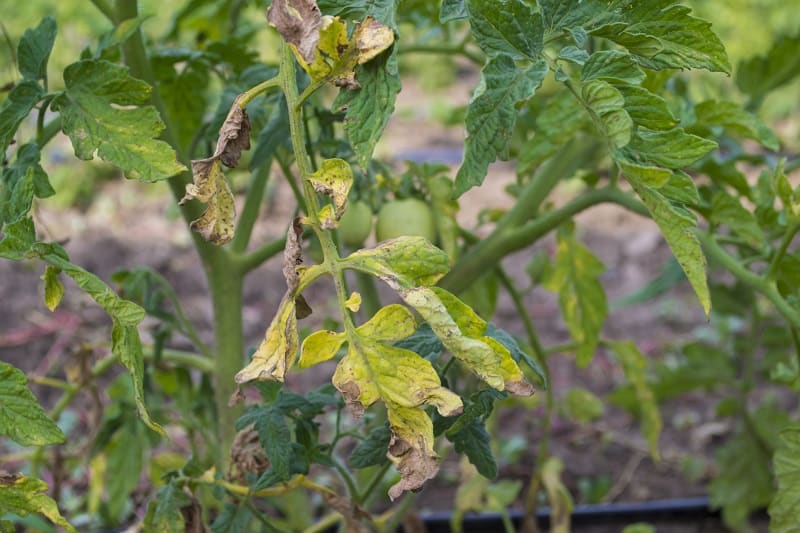
The most common reason your vegetable plant’s leaves may turn yellow is due to your watering technique. The problem can be either overwatering or underwatering. If you have plants with yellowing leaves, check whether the soil in the pot is dry or boggy.
Other causes of yellowing leaves in vegetable plants are nutrient deficiency, temperature, and pests.
In this article, we discuss the different causes of yellowing vegetable plant leaves and how to remedy each one.
Why Are My Vegetable Leaves Turning Yellow?
Watering techniques
Plant leaves can turn yellow from overwatering. If the plant is in soil that does not drain well, the roots will drown and die. This will make the plant susceptible to bacterial and fungal diseases, and the rot will make its way to the plant’s stem and leaves. The leaves will turn yellow and eventually fall off. If the plant is not salvaged in time, it will die.
The best way to correct overwatering is to make sure that you always wait until the soil is dry before watering it again. If you have been watering your plant every three days, try watering it every five days and see if its color improves. It is also important that the pot or container has drainage holes at the bottom to allow the excess water to flow out in case you accidentally overwater it.
You can also repot an overwatered plant. When transferring the plant, check its roots and cut off any segments that are brown or black. Plant it in fresh soil and do not water the plant for a week after repotting. This gives the plant’s roots enough time to heal so they can effectively absorb water again.
Underwatering your plant can also cause yellowing leaves. If plants do not get the amount of water that they need each day, their leaves will turn yellow, then brown, and finally drop off. Plants do this when they are underwatered because they are trying to conserve water and energy to keep themselves alive. The more leaves they have, the more leaves they have to keep alive, so shedding leaves will help prioritise the life of the plant itself.
Sometimes the reason the plant is underwatered relates to how you are watering it, rather than how much water you are giving it. In order to encourage the plant’s roots to grow deeper downward, water it less but make sure you concentrate the water until it reaches the bottom of the soil in the pot. Check the soil in the pot by touching it. If the top inch of soil is dry, you can water the plant. If the top inch of soil is still a bit damp, wait one or two days before checking the soil again.
Nutrient deficiencies
A lack of nutrients is apparent when the top leaves of the plant are yellowing.
Calcium deficiency
This deficiency results in distorted, mottled or crinkled leaves. The tips of the leaves will also refuse to grow. You can correct this by adding agricultural lime to the soil.
Magnesium deficiency
This will cause the yellowing of leaves between the veins, while the veins remain green. This will usually appear on the plant’s lower leaves.
Nitrogen deficiency
This deficiency can cause stunted growth in your vegetable plants. Yellow edges will appear on your leaves. The veins will also become yellow, and the entire leaf will be a paler yellow. You can remedy this by adding coffee grounds to the soil, as this helps supply it with nitrogen.
Potassium deficiency
This deficiency causes the older leaves to develop yellow and brown spots, yellow edges or yellow and brown veins. You can remedy this by adding a potassium fertilizer containing potash.
Iron deficiency
This causes yellowing of the leaves, stunted growth and chlorosis. You can detect this by using a soil gauge to determine the soil pH. Make sure the pH is neutral or acidic.
Changes in temperature
If your plant is left out in the full sun for the entire day, every day, it should come as no surprise that it will suffer significant sun damage. This includes the leaves turning yellow and brown. Keep the plant in an area where the temperature is between 50 and 80 degrees Fahrenheit.
In the winter, plants that are native to tropical climates will have a hard time in the cold. Make sure you bring them indoors and keep them away from cold drafts around the house. Keep them away from air conditioners and purchase a grow lamp if you can. This can help give the plant its much needed light and also keep it warm.
Pests
If you find yellow spots on your leaves, inspect the leaves and see if you can spot small insects. It is possible that your yellowing leaves are caused by pests.
It is easier to know how to treat a pest problem if you know which bug you are dealing with. The most common pests that go after vegetable plants are whiteflies, scale insects, thrips, mealybugs, aphids and mites.
You can use horticultural soap if you want to try and get rid of the pests using an environmentally safe product.
Make sure you move the infested plant to an area far away from your other plants. This way it is isolated and you do not risk your other plants getting infested as well. Treat the plant once a week for a month to make sure all the bugs are killed.
Conclusion
Vegetable leaves usually turn yellow due to mistakes in your watering techniques. Overwatering and underwatering your plants can both result in the yellowing of your plant’s leaves.
Other causes of yellowing vegetable leaves include nutrient deficiency, changes in temperature, and pests.
As long as you are able to properly provide your plants’ basic needs, they will thrive in your garden.
Image: istockphoto.com / KalebKroetsch